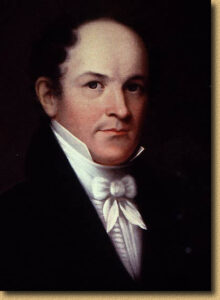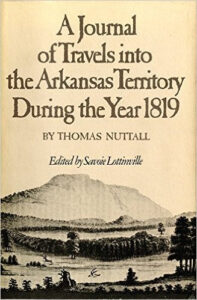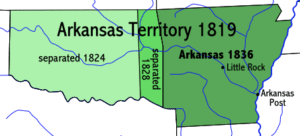
Two hundred years ago the land that is now eastern Oklahoma and western Arkansas was “Arkansas Territory”–not yet the states of Arkansas and Oklahoma, not yet the Choctaw and Cherokee Nations.
Into this Arkansa Territory, only recently carved from the lands of the Louisiana Purchase, traveling by boat and on foot, came an English botanist and explorer, Thomas Nuttall.
The first scientist in the European tradition to visit either state, Nuttall left a journal of his travels. For the 2019 bicentennial of his trip, we held several workshops & field trips retracing various portions of his path.
 Nuttall’s journey in the Arkansa Territory began at Arkansas Post near the confluence of the Arkansas River with the Mississippi. His intention was to follow the river west all the way to the Rocky Mountains in present day Colorado. After traveling across what is now the state of Arkansas he arrived at the only recently established Fort Smith, AR on April 24, 1819. He stayed for several weeks at the fort, botanizing and exploring nearby prairies and riparian woodlands.
Nuttall’s journey in the Arkansa Territory began at Arkansas Post near the confluence of the Arkansas River with the Mississippi. His intention was to follow the river west all the way to the Rocky Mountains in present day Colorado. After traveling across what is now the state of Arkansas he arrived at the only recently established Fort Smith, AR on April 24, 1819. He stayed for several weeks at the fort, botanizing and exploring nearby prairies and riparian woodlands.
While there he took a side trip south with his Army hosts to the Red River. They traveled from the confluence of the Poteau River with the Arkansas at Fort Smith to the mouth of the Kiamichi River at the Red River. The trip was essentially a transect of what would eventually become the Choctaw Nation.
After that trip south, Nuttall left Fort Smith and continued upstream on the Arkansas River to the Three Forks area (near present day Fort Gibson, Oklahoma) and then further west and north to somewhere in the vicinity of what is now Tulsa, Oklahoma. A severe bout of malaria finally forced him to abandon his plans to continue all the way to the Rockies.

For several years in advance of the 2019 bicentennial of Nuttall’s trip, we conducted workshops and field trips exploring his observations and revisiting the land he saw. Now that the bicentennial has past, Nuttall’s A Journal of Travels into the Arkansa Territory During the Year 1819 remains a lens through which we can visualize what this land was like 200 years ago, how it has changed in the years since, and fire our ecological imaginations as we contemplate what the next 200 years may bring.
Nuttall published his Journal in 1821. It is in print today in several editions–I recommend the annotated version published by the University of Oklahoma Press, edited by Savoie Lottinville.

